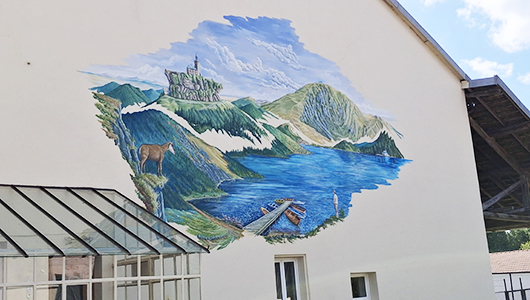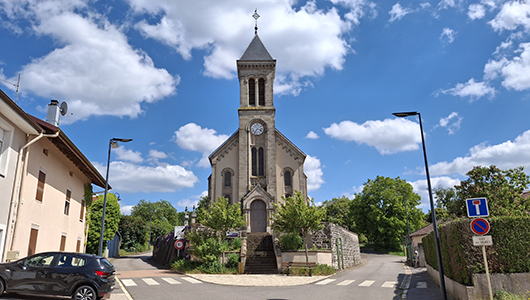Saint-Gorgon
Durée visite à pied : 20 minutes
Durée visite à vélo : 20 minutes
L’implantation romaine est attestée par la présence d’une voie romaine, aujourd’hui chemin Sondrot. La seigneurie foncière de Saint-Gorgon appartenait à l’abbesse du chapitre d’Épinal. Elle nommait le maire, le lieutenant et le greffier et tenait le plaid banal, tribunal de basse justice. La haute justice dépendait du duc de Lorraine. Au spirituel, Saint-Gorgon était associé à Sainte-Hélène. Tous deux formaient une paroisse dont la collation appartenait à l’abbesse de Remiremont. Celle-ci percevait les deux tiers des dîmes, l’autre tiers allant au curé. Saint-Gorgon fut ensuite annexe de la paroisse de Rambervillers. Le village rémunérait les services d’un vicaire spécial. Il y avait 178 habitants en 1793, 162 en 1901 et 366 en 2022.
The Roman settlement is attested by the presence of a Roman road, today the Sondrot Road. The landed lordship of Saint-Gorgon belonged to the abbess of the Epinal chapter. She appointed the mayor, the lieutenant, and the clerk and held the banal court, a court of lower justice. High justice depended on the Duke of Lorraine. In spiritual matters, Saint-Gorgon was associated with Saint Helena. The two formed a parish whose collation belonged to the abbess of Remiremont. She received two-thirds of the tithes, the other third going to the parish priest. Saint-Gorgon was later annexed to the parish of Rambervillers. The village paid for the services of a special vicar. There were 178 inhabitants in 1793, 162 in 1901, and 366 in 2022.
Die römische Siedlung ist durch das Vorhandensein einer Römerstraße, der heutigen Sondrot-Straße, belegt. Die Grundherrschaft Saint-Gorgon gehörte der Äbtissin des Kapitels von Épinal. Sie ernannte den Bürgermeister, den Leutnant und den Schreiber und hielt das Banalgericht, ein Gericht der unteren Gerichtsbarkeit. Die hohe Gerichtsbarkeit unterlag dem Herzog von Lothringen. In geistlichen Angelegenheiten war Saint-Gorgon mit der Heiligen Helena verbunden. Die beiden bildeten eine Pfarrei, deren Kollation der Äbtissin von Remiremont gehörte. Sie erhielt zwei Drittel des Zehnten, das andere Drittel ging an den Pfarrer. Saint-Gorgon wurde später der Pfarrei Rambervillers angegliedert. Das Dorf bezahlte die Dienste eines besonderen Pfarrers. 1793 gab es 178 Einwohner, 1901 162 und 2022 366.

Les habitants de Saint-Gorgon s’appellent les Gorgonnais et les Gorgonnaises.
The inhabitants of Saint-Gorgon are called Gorgonnais and Gorgonnaises.
Die Einwohner von Saint-Gorgon werden Gorgonnais und Gorgonnaises genannt.
Les points de visites
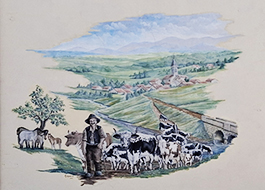
.
Admirez ces magnifiques trompe-l’œil. Oui, ce nom est invariable. De plus, le trait d’union se maintient dans la locution en trompe-l’œil (à la différence de en bas relief, en ronde bosse). De l’Art à la Grammaire, il n’y a ici qu’un pas !
Admire these magnificent trompe-l’oeils. Yes, this name is invariable. Moreover, the hyphen remains in the expression trompe-l’oeil (unlike in bas-relief, in the round). From Art to Grammar, there is only one step here!
Bewundern Sie diese prächtigen Trompe-l’œils. Ja, dieser Name ist unveränderlich. Außerdem bleibt der Bindestrich im Ausdruck Trompe-l’œil erhalten (im Gegensatz zum Flachrelief, das rund ist). Von der Kunst zur Grammatik ist es hier nur ein Schritt!
.
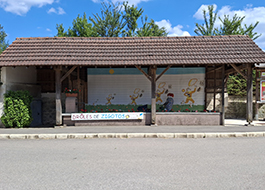
.
À l’origine, le lavoir est une pierre plate ou une simple planche posée au bord d’un cours d’eau, d’une mare ou d’une source, sans abri. La pollution liée à la révolution industrielle, les épidémies et le souci de l’hygiène provoquent le développement de constructions spécifiques, à la fin du XVIIIe siècle. Les communes s’équipent de bassins situés au bas d’une prairie, en contrebas d’une source ou d’une fontaine, en bordure d’un ruisseau, d’un canal, d’une rivière voire d’un fleuve où peut être amarré un bateau-lavoir. Contrairement à ce que suggère le décor, les enfants étaient tenus éloignés de ces lieux, par souci de sécurité. Des histoires horribles étaient censées les effrayer.
Originally, the wash house was a flat stone or a simple plank placed at the edge of a watercourse, a pond or a spring, without shelter. Pollution linked to the industrial revolution, epidemics and the concern for hygiene led to the development of specific constructions at the end of the 18th century. The municipalities equipped themselves with basins located at the bottom of a meadow, below a spring or a fountain, on the edge of a stream, a canal, a river or even a river where a wash boat could be moored. Contrary to what the decor suggests, children were kept away from these places, for safety reasons. Horrible stories were supposed to frighten them.
Ursprünglich war das Waschhaus ein flacher Stein oder ein einfaches Brett, das ungeschützt am Rande eines Wasserlaufs, Teichs oder einer Quelle aufgestellt wurde. Die mit der industriellen Revolution verbundene Umweltverschmutzung, Epidemien und der Wunsch nach Hygiene führten Ende des 18. Jahrhunderts zur Entwicklung spezifischer Konstruktionen. Die Gemeinden richteten sich Waschbecken am Ende einer Wiese, unterhalb einer Quelle oder eines Brunnens, am Rande eines Bachs, Kanals, Flusses oder sogar eines Flusses ein, an dem ein Waschboot anlegen konnte. Anders als die Dekoration vermuten lässt, wurden Kinder aus Sicherheitsgründen von diesen Orten ferngehalten. Gruselgeschichten sollten ihnen Angst machen.
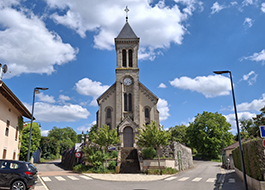
.
Elle date du XIXe siècle. Elle est dédiée à saint Gorgon. Voici son histoire, déconseillée aux âmes sensibles. Il était officier de l’empereur Dioclétien au début du IVe siècle. Converti au christianisme, il refusa de renier sa foi. Suspendu au chevalet, sa peau est arrachée par des onglets de fer. Puis les bourreaux lui avivent ses plaies avec du sel et du vinaigre. Enfin, Gorgon est lentement pendu pour être étranglé jusqu’à la mort. Il fut enseveli dans une nécropole, le long de la via Labicana, à Rome. Ses reliques sont rapportées en 766 par l’évêque de Metz, Chrodegang, pour l’abbaye de Gorze, qu’il avait fondée peu avant. Au XIe siècle, quelques-unes de ses reliques sont transférées à l’abbaye messine de Saint-Arnould et à celle de Cluny, à partir de laquelle son culte se répand en France.
It dates from the 19th century. It is dedicated to Saint Gorgon. Here is his story, not recommended for the faint of heart. He was an officer of Emperor Diocletian at the beginning of the 4th century. Converted to Christianity, he refused to renounce his faith. Suspended from the rack, his skin was torn off by iron tabs. Then the executioners revived him with salt and vinegar. Finally, Gorgon was slowly hanged to be strangled to death. He was buried in a necropolis along the Via Labicana in Rome. His relics were brought back in 766 by the Bishop of Metz, Chrodegang, for the Abbey of Gorze, which he had founded shortly before near Metz. In the 11th century, some of his relics were transferred to the Abbey of Saint-Arnould in Metz and to the Abbey of Cluny, from where his cult spread throughout France.
Es stammt aus dem 19. Jahrhundert. Es ist der Heiligen Gorgon gewidmet. Hier ist seine Geschichte, nichts für schwache Nerven. Er war zu Beginn des 4. Jahrhunderts ein Offizier von Kaiser Diokletian. Er konvertierte zum Christentum, weigerte sich aber, seinem Glauben abzuschwören. An der Streckbank aufgehängt, wurde seine Haut an Eisenlaschen abgerissen. Dann erweckten ihn die Henker mit Salz und Essig wieder zum Leben. Schließlich wurde Gorgon langsam gehängt, um erwürgt zu werden. Er wurde in einer Nekropole an der Via Labicana in Rom begraben. Seine Reliquien wurden 766 vom Bischof von Metz, Chrodegang, für die Abtei Gorze zurückgebracht, die er kurz zuvor in der Nähe von Metz gegründet hatte. Im 11. Jahrhundert wurden einige seiner Reliquien in die Abtei Saint-Arnould in Metz und in die Abtei Cluny überführt, von wo aus sich sein Kult in ganz Frankreich verbreitete.
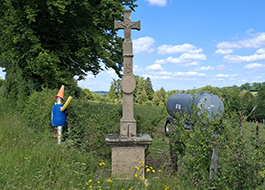
Cette croix a été érigée en 1648. L’inscription latine indique que la croix est l’espérance unique du chrétien. Elle peut protéger le voyageur ou le champ voisin. On s’y arrêtait pour se recueillir et prier.
This cross was erected in 1648. The Latin inscription indicates that the cross is the Christian’s only hope. It can protect the traveler or the neighboring field. People stopped there to meditate and pray.
Dieses Kreuz wurde 1648 errichtet. Die lateinische Inschrift besagt, dass das Kreuz die einzige Hoffnung des Christen ist. Es kann den Reisenden oder das benachbarte Feld schützen. Menschen hielten dort an, um zu meditieren und zu beten.

